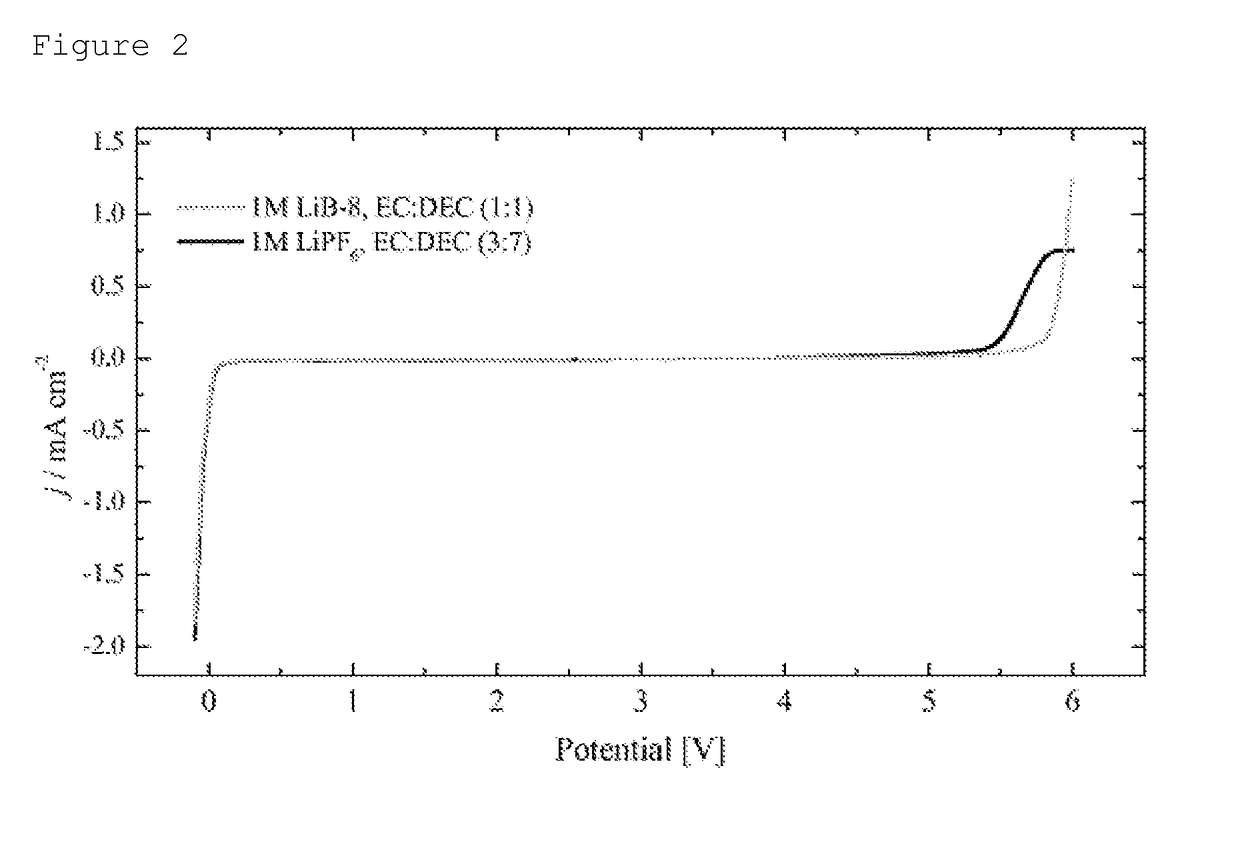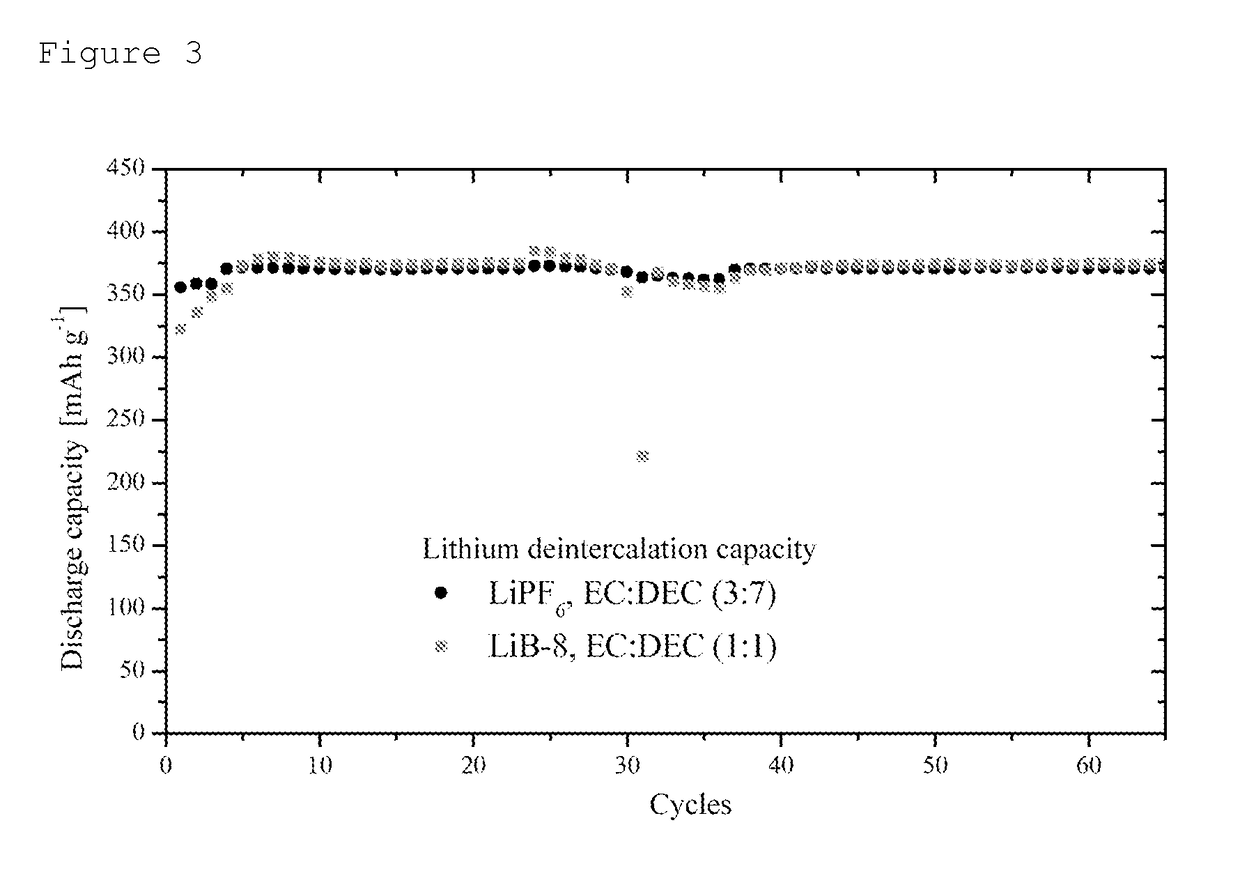Electrolyte salt for lithium-based energy stores
a lithium-based energy storage and electrolyte technology, applied in lithium compounds, cell components, electrochemical generators, etc., can solve the problems of only a low solubility of bis(oxalato)borate in carbonates, low thermal stability, and disadvantages, and achieve good thermal and electrochemical stability and good solubility in organic solvents
- Summary
- Abstract
- Description
- Claims
- Application Information
AI Technical Summary
Benefits of technology
Problems solved by technology
Method used
Image
Examples
example 1
Preparation of lithium 1-trifluoromethoxy-1,2,2,2-tetrafluoroethanesulfonate
a) Preparation of 1,2,2,2-tetrafluoro-1-(trifluoro-methoxy)ethanesulfonyl fluoride
[0050]10 mg of tetramethylammonium fluoride (ABCR) were suspended in 10 ml of dry bis(2-methoxyethyl) ether (diglyme, ABCR). At −197° C., 36 mmol of sulfuryl difluoride (ABCR) and 36 mmol of 1,1,2-trifluoro-2-(trifluoromethoxy)ethene (ABCR) were condensed in. The reaction mixture was heated to 60° C. for 12 h and then the product was distilled. 1,2,2,2-Tetrafluoro-1-(trifluoromethoxy)ethanesulfonyl fluoride was obtained as a colorless liquid in a yield of 92%.
b) Preparation of lithium-1,2,2,2-tetrafluoro-1-(trifluoromethoxy)ethanesulfonate
[0051]20 mmol of the 1,2,2,2-tetrafluoro-1-(trifluoro-methoxy)ethanesulfonyl fluoride prepared in step a) were dissolved in 10 ml of ethanol (ROTH). At 0° C., 40 mmol of lithium hydroxide (ROTH) were added. The suspension was stirred at room temperature (20±3° C.) for 2 h, then centrifuged for...
example 2
Determination of the conductivity of lithium 1-trifluoromethoxy-1,2,2,2-tetrafluoroethanesulfonate
[0053]The conductivity of lithium 1-trifluoromethoxy-1,2,2,2-tetrafluoroethanesulfonate was determined in different solvents within a temperature range from −40° C. to +60° C.
[0054]Mixtures of 50% by weight of ethylene carbonate (EC) (Ferro Corporation, battery grade) and 50% by weight of diethyl carbonate (DEC) (Ferro Corporation, battery grade) (EC:DEC, 1:1), of 50% by weight of ethylene carbonate and 50% by weight of gamma-butyrolactone (γ-BL) (Ferro Corporation, battery grade) (EC:γ-BL, 1:1), and 45% by weight of ethylene carbonate, 45% by weight of gamma-butyrolactone and 10% by weight of fluoroethylene carbonate (Solvay GmbH) (EC:γ-BL:FEC, 4.5:4.5:1) were prepared. In these solvent mixtures were dissolved 217 mg per milliliter of the lithium 1-trifluoromethoxy-1,2,2,2-tetrafluoroethanesulfonate prepared according to example 1, so as to give a concentration of 1 M. For comparison, ...
example 3
Determination of the electrochemical stability of lithium 1-trifluoromethoxy-1,2,2,2-tetrafluoroethane-sulfonate
[0059]The electrochemical stability of a 1 M solution of lithium 1-trifluoromethoxy-1,2,2,2-tetrafluoroethane-sulfonate prepared according to example 1 in a solvent mixture of 50% by weight of ethylene carbonate and 50% by weight of diethyl carbonate (EC:DEC, 1:1) compared to the stability of a 1 M solution of LiPF6 (Sigma-Aldrich, battery grade) in a mixture of 30% by weight of ethylene carbonate and 70% by weight of diethyl carbonate (EC:DEC, 3:7) was determined by means of linear sweep voltammetry (LSV). In this method, there is a continuous change in the electrode voltage (linear sweep).
[0060]The cathodic stability limit, the potential at which reduction sets in, was defined as that potential at which the current density falls below −0.1 mA cm−2. The anodic stability limit, the potential at which oxidation sets in, was defined as that potential at which the current den...
PUM
 Login to View More
Login to View More Abstract
Description
Claims
Application Information
 Login to View More
Login to View More - R&D
- Intellectual Property
- Life Sciences
- Materials
- Tech Scout
- Unparalleled Data Quality
- Higher Quality Content
- 60% Fewer Hallucinations
Browse by: Latest US Patents, China's latest patents, Technical Efficacy Thesaurus, Application Domain, Technology Topic, Popular Technical Reports.
© 2025 PatSnap. All rights reserved.Legal|Privacy policy|Modern Slavery Act Transparency Statement|Sitemap|About US| Contact US: help@patsnap.com



